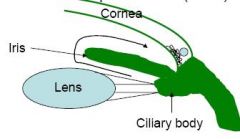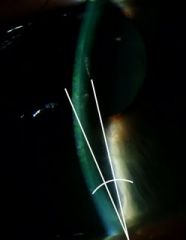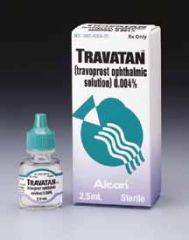![]()
![]()
![]()
Use LEFT and RIGHT arrow keys to navigate between flashcards;
Use UP and DOWN arrow keys to flip the card;
H to show hint;
A reads text to speech;
50 Cards in this Set
- Front
- Back
|
(a) What is glaucoma?
|
Increased IOP --> optic nerve damage --> progressive visual field loss
|
|
|
(a) How is IOP reduced pharmacologically and surgically?
|
1. reduce production of aqueous humour
2. increase outflow of aqueous humour 3. peripheral laser iridotomy |
|
|
How is aqueous humour made?
How is aqueous humour lost? |

1. AH made by ultrafiltration of blood vessels at ciliary body in the posterior chamber
2. Passes between lens and iris into anterior chamber, and passes out through filtration angle between iris and cornea and then diffuses into the TREBCULAR MESHWORK (CT) through the CANAL OF SCHLEMM in the sclera *Also, some AH diffuses out via UVEOSCLERAL PATHWAY (4-18%) |
|
|
What is normal IOP?
|
10-21mmHg, average about 15mmHg
|
|
|
Open angle glaucoma
- risk factors? - early signs? |
Risk factors
- age, family Hx Early signs - frequent lens changes - mild headache - halos around lights - impaired dark adaptation |
|

Closed angle glaucoma
- what is the closed angle? - what is the IOP? - we covered S+S under Red Eye so you don't have to repeat here: remember: mydrisasis vs. miosis (uveitis) |

- closed angle between the cornea and the iris
- IOP is ~50mmHg |
|
|
What are secondary causes of glaucoma?
|
- trauma
- inflammation - tumours - cataracts - PROLONGED CORTICOSTEROID DROPS |
|
|
(a) What is one barrier to treatment of chronic open angle glaucoma (OAG)?
(b) what is the target IOP? |
(a) compliance is equal to or greater than 50%
(b) it depends on each patient and is set by the specialist - e.g. extent of retinal damage, site of damage, family history |
|
|
Holding tear ducts closed - how long and what effect?
Another important counselling point for these drops? |
1. 3mins
2. up to 70% reduction in systemic absorption Seperate drops by at least 5 minutes |
|
|
OAG - what are the treatments and which are used first, second, third?
** Consider this question as in the context of a potential exam question |
1. Prostaglandin analogues (bimatoprost, latanoprost, and travaprost)
2. Beta-blockers (betaxolol, levobunolol, timolol) THEN 2. Alpha2 agonist (brimonidine, apraclonidine) 3. Topical carbonic anhydrase inhibitor (brinzolamide, dorzolamide) 3. Cholinergic (Pilocarpine) 4. Nonselective adrenergic agonist (Dipivefrine) Also acetazolamide (as effective as BB and prostaglandins), mannitol used more frequently for CAG **When getting to last line, consider: (1) compliance, (2) holding tear duct closed, (3) trying different prostaglandins ** Or surgery: trabeculectomy or insertion on a mini shunt |
|
|
OAG - which are
(A) most effective (b) least effective (c) least dosed (d) most dosed |

|
|
|
Prostaglandin analogues
- drugs in class - mode of action - comparative efficacy |
1. Bimatoprost, Travaprost, Latanoprost
2. Analogues of PG-F2alpha Increase uveoscleral outflow of AH 3. Evidence of increased efficacy cf Beta blockers |
|
|
Prostaglandin analogues
- CIs, cautions - Pregnancy - BF - LF and RF are okay |
- CI: active introcular inflammation, such as uveitis; caution if there is a history of this
- Latanoprost increases recurrence of ocular herpes simplex - B3: no data, avoid - BF: no data, but unlikely to be a concern - LATANOPROST is safe to use |
|
|
Prostaglandin analogues
- Adverse effects |
Common
- gradual usually irreversible darkening of iris, especially if mixed colored eye (concern if only one eye is treated) - lengthening and thickening of eye lashes - transient conjunctival hyperaemial - latanoprost causes ocular irritation and bitter taste due to preservative; the others can cause itch |
|
|
Prostaglandin analogues
- are they equally effective? - can two be used together - specific counselling points (2) |
- yes, but they are structurally different so if response to one is poor, consider trying another
- No! may cause paradoxical increase in IOP - (1) use at night for increased effect (2) may change eye color gradually, and is more noticeable if only one eye is treated |
|
|
Latanoprost
- products, combo products |
Xalatan - 0.005%, 2.5mL
Xalacom - 0.005%/0.5%, 2.5mL with Timolol |
|
|
Bimatoprost
- product |

Lumigan - 0.03%, 3mL
|
|
|
Travaprost
- products |

Travatan - 0.004%, 2.5mL
DuoTrav - 0.004%/0.5%, 2.5mL with timolol |
|
|
Dosage of prostaglandin analogues alone and in combination?
|
Alone: 1 drop daily, preferably at night
With timolol: 1 drop daily, preferably at night |
|
|
Beta-blocker eye drops
- drugs in class - mode of action |
- levobunolol, betaxolol, timolol
- Reduce production of AH by 1/3 by blockade of beta-2 receptors on ciliary body epithelium - NB: there is no B1 receptors in the eye - NB: betaxolol is B1 selective when NOT used in the eye. - The other BBs are not selective |
|
|
Beta-blocker eye drops
- CI/cautions - Preg - BF - N.B. ok in liver and renal disease |
1. CI in asthma but B1 selective betaxolol may be used with care
2. Caution in CVD 3. Avoid combination with systemic BB (increased risk of sytemic A/Es and decreased result as systemic BB already reduces IOP somewhat) 4. Avoid use with verapamil - Also use with caution in children, the elderly and in surgery - Pregnancy: C: fetal bradycardia occurs - BF: unlikely to cause A/Es |
|
|
BB eye drops
- A/Es |
Common:
- stinging on instillation (especially betaxolol SOLUTION) - bradycardia Infrequent - hypotension, fatigue, syncope, hallucinations, bronchospasm *NB: betaxolol suspension is as effective as the solution by has less stinging |
|
|
BB eye drops
- which is more effective? - how long do they work for? - how long do they work after they are stopped? |
- Betaxolol is slightly less effective than the others and has more stinging, but is less likely to cause bronchospasm
- There may be a slight decrease in effect in the first month, and then tolerance may develop after 1 year - after stopping, returns to baseline in 2-4 weeks |
|
|
Betaxolol
- products |

0.25%.5mL suspension (Betoptic-S)
0.5%.5mL solution (Betoptic, Betoquin) |
|
|
Levobunolol
- products |
0.25%.5mL (Betagan)
|
|
|
Timolol
- products |
0.25%.5mL solution (Tenopt, Timoptol)
0.25%.2.5mL SR solution (Timoptol-XE) 0.5%.5mL solution (Tenopt, Timoptol) 0.5%.2.5mL SR solution (Timoptol- XE) 0.1%.5g eye gel (Nyogel) 0.5%/0.005%.2.5mL (Xalacom - with latanoprost) 0.5%/0.004%.2.5mL (DuoTrav - with travaprost) 0.5%/2%.5mL (Cosopt - with dorzolamide) 0.5%/0.2%.5mL (Combigan - with brimonidine) |
|
|
Dosing of BB eye drops
|
Betaxolol (Betoptic) and Levobunolol (Betagan): 1 bd
Timolol solution: 1 d-bd (0.25-0.5%) Timolol XE solution: 1 d (0.25-0.5%) Timolol gel: 1 DROP d Xalatan, DuoTrav: 1 n. Combigan, Cosopt: 1 bd. |
|
|
Alpha-2 agonist eye drops
- drugs in class - mode of action |
- apraclonidine and brimonidine
- Reduces production of AH, and increases uveoscleral outflow of AH |
|
|
Alpha-2 agonists eye drops
-A/Es |
Common
- occular irritation - dry mouth and nose - taste disturbance - Apraclonidine has high incidence of allergic reactions after 3/12 use - Brimonidine: fatigue, dizziness Infrequent - palpitations, reduced BP |
|
|
Is apraclonidine better than brimonidine?
When is apraclonidine used? Specific counselling point for brimonidine? |
- slightly better (5% increased IOP reduction) HOWEVER apraclonidine is only for short term use (3/12) as its effect declines after a month
- Apraclonidine may be used before surgery for CAG and last line, short use addition to OAG - Label 1 & 16 |
|
|
Apraclonidine - products
|
0.5%.5 and 10mL (Iopidine)
|
|
|
Brimonidine - products including combo
|

Alphagan, Enidin
0.2%.5mL Combigan - 0.5/0.2% |
|
|
Dosing of alpha-2 agonists
|
1 bd-tds
Combigan: bd |
|
|
Carbonic anhydrase inhibitors (CAIs)
- drugs in class (topical) - MOA |
- brinzolamide, dorzolamide, acetazolamide
- inhibits CA II, which reduces product of AH |
|
|
CAIs
- CIs - Preg - BF |
- Allergy to sulphonamides!!!! - increased risk of allergy to CAI
- Preg B3 - no data - BF: no data |
|
|
CAIs
- A/Es |
Common
- irritation - foreign body sensation - bitter taste Infrequent: blepharitis, corneal staining Rare: allergy |
|
|
CAI
- place in therapy? - specific counselling point |
- after or with BBs
- You may initially experience eye discomfort or blurred vision |
|
|
Brinzolamide - products
|

1%.5mL (Azopt, BrinzoQuin)
|
|
|
Dorzolamide
- products |

2%.5mL (Trusopt)
2%/0.5%.5mL (Cosopt - with timolol) |
|
|
CAI
- dosing |
Trusopt: 1 tds
Cosopt: 1 bd Azopt: 1 bd |
|
|
Acetazolamide
- products - indications - contraindications |
- 250mg.100 tabs (Diamox), and also IV on SAS
- CAG, last line OAG, epilepsy in particular absense seizures - CI: metabolic acidosis, renal, adrenal, respiratory or hepatic failure - Sulphur allergy - May worsen gout, kidney stones |
|
|
Diamox
- side effecst - counselling point |
- up to 50% do not tolerate Diamox
- tingling, fatigue, depression, decreased libido, taste disturbance, n/v/abdo cramps, black faeces, kidney stones, acidosis, electrolyte disturbance INFREQUENT: SJS Take with food to reduce stomach upset |
|
|
Dipivefrine
- MOA - products |
- Pro-drug of adrenaline. Alpha agonist: increases uveoscleral outflow. Beta agonist: decreases aqueous inflow
- Propine 0.1%.10mL |
|
|
Propine
- A/Es |
Common
- irritation - Allergy with long term use - rebound hyperaemia 2hr after use - pigmentation of conjunctiva (long term) - mydriasis - frontal headach Rare: palpitations, anxiety, HTN, increased HR |
|
|
Propine
- dose - place in therapy - use with BBs |
1 bd
Limited use due to low efficacy and frequent occular A/Es Limited additional effect when used with pilocarpine, dorzolamide or betaxolol Use at least 5 mins before BBs |
|
|
Pilocarpine
- MOA |
- Cholinergic: contracts iris and ciliary muscle (miotic), causing increased outflow through trabecular meshwork
|
|
|
Pilocarpine
- products |
0.5%, 1%, 2%, 3%, 4%, 6% (Pilopt, Isopto Carpine, P.V. Carpine)
1%, 2%, 4% x20 single use drops (Minims Pilocarpine Nitrate) |
|
|
Pilopt
- A/Es |
Common (Dose dependent):
- miosis, blurred vision & frontal headache (usually decreases after 2-4 weeks) - occular irritation Miosis is potentially permanent with long term use, and may worsen vision: reassess visual acuity for driving. |
|
|
Isopto Carpine
- indications - Preg/Bf |
- OAG, pre-surgery CAG, reversal of weak mydriatics (not recommended)
- CI: uveitis (like prostaglandin analogues), secondary glaucoma due to outflow obstruction (may worsen) - Be: ltd data - BF: safe to use |
|
|
Pilopt
- dosing |
Start on 0.5-1% 1 tds-qid
Usual: 2% qid Maximum: 4% qid with light iris, 6% qid with dark iris (Perhaps darkness is related to thickness of iris sphincter) To reverse mydriasis: 1% drop For OAG: 4% every 5min until miosis |

